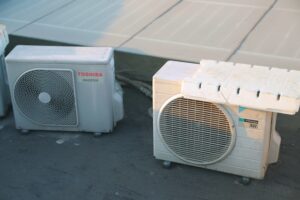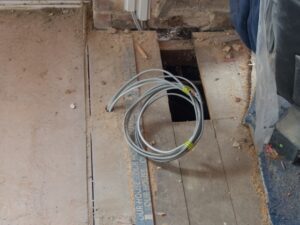Have you ever noticed a dark, unpleasant stain inside your toilet tank and wondered, “Where is that coming from?”
Well, the culprit is likely mold.
It might not be something you see often, but mold in your toilet tank can be a common and sneaky issue that arises from the perfect storm of moisture, heat, and lack of regular cleaning.
Mold thrives in warm, damp environments, and toilet tanks provide just that—an ideal spot for it to grow. When water isn’t flushed regularly, it can create the perfect breeding ground for mold to settle in, especially in less visible areas.
Not only does this make your toilet look unappealing, but it can also lead to bigger problems if left untreated.
But don’t panic!
You don’t need harsh chemicals to tackle this issue.
Regular cleaning and maintenance go a long way. And hey, if you’re ever unsure or need expert help, companies like Excel Mechanical are here to assist. They offer exceptional plumbing and HVAC services for both homes and businesses, so you can trust that your plumbing is in good hands.
In this blog, we will discuss:
- Why mold grows in toilet tanks and what causes it.
- How regular cleaning and maintenance can prevent mold buildup.
- Tips and expert advice on handling persistent mold problems.
So, let’s dive in!
Understanding Mold in Toilet Tanks
So, why exactly does mold love to make its home in your toilet tank?
It’s not just about your toilet needing a quick scrub here and there.
Mold thrives in damp, dark places, and the inside of a toilet tank fits that description perfectly. Combined with the minerals found in hard water, the tank becomes an inviting environment for mold to grow.
Now, if you’re wondering how to stop this pesky mold from returning, it all starts with regular cleaning and proper maintenance. Skipping out on cleaning allows mold to grab hold and thrive, but if you’re proactive about scrubbing the tank and checking it regularly, you’ll stay ahead of the game.
Do you have a fan in your bathroom?
If not, adding one can really help.
Since mold loves moisture and stagnant air, improving airflow in your bathroom by using a fan or opening a window can go a long way in preventing future mold buildup.
And let’s not forget the role of your water.
Hard water, which contains higher levels of minerals like calcium and magnesium, can actually help mold grow inside the tank. If you’re using hard water, a water softener might be a smart solution to minimize this issue.
Here’s the thing: keeping your toilet tank mold-free isn’t just about cleaning—it’s about managing the moisture, the airflow, and even the quality of the water you’re using.
Common Causes of Mold Growth
Mold in your toilet tank is not just an eyesore; it’s a symptom of a bigger issue.
Understanding why mold grows in the first place can help you take the right steps to prevent it from coming back. Here are some of the most common causes:
- Moisture: Mold needs dampness to grow. The tank is usually humid, making it a perfect spot.
- Lack of Sunlight: Bathrooms are often dimly lit. Without sunlight, mold can thrive.
- Irregular Cleaning: Skipping regular cleanings allows mold to take hold.
- Water Quality: Poor quality or untreated water may carry minerals and impurities that promote mold growth.
- Poor Ventilation: Without proper airflow, the moisture stays trapped, helping mold grow.
Now that you know why mold grows in your toilet tank, the next step is taking action.
Excel Mechanical offers expert plumbing services to tackle mold and water issues head-on, ensuring your toilet stays in top condition.
Health Implications of Mold
You might think mold is just an inconvenience, but it can actually affect your health in serious ways. That mold you see growing in your toilet tank isn’t just gross—it’s potentially harmful.
Let’s break down the health risks and how they can impact you and your family.
Allergic Reactions
If you’re allergic to mold, even a small amount can trigger symptoms. You might experience sneezing, runny nose, itchy eyes, or skin rashes. These responses are due to your immune system reacting to mold spores.
Certain individuals are more sensitive than others and can suffer from severe reactions.
Kids, older adults, and those with a weak immune system should be extra cautious.
Keeping areas in your home mold-free is always a best practice for health. Regular cleaning can help reduce mold growth in places like your toilet tank.
Respiratory Issues
Mold isn’t just uncomfortable—it can also affect your breathing.
If you’re prone to asthma, mold can exacerbate symptoms, leading to wheezing, coughing, or shortness of breath.
Even if you’re not asthmatic, constant exposure to mold spores can still harm your lungs over time. It’s like putting your lungs through a workout they didn’t sign up for! And those with pre-existing respiratory issues are especially at risk.
If you’ve ever felt short of breath after cleaning out your toilet tank and disturbing the mold, that’s your body’s way of telling you to be more careful.
Mold spores can get airborne and travel into your lungs, causing irritation that could lead to chronic breathing problems if not addressed quickly.
Long-Term Health Effects
Chronic exposure to mold isn’t something to shrug off.
It’s linked to more serious respiratory conditions, especially in children and the elderly. Long-term exposure can also lead to persistent headaches, fatigue, and difficulty concentrating.
So, what starts as a small problem in your toilet tank could snowball into bigger health issues if left unchecked.
Now that you understand the potential health risks, it’s clear why mold in your toilet tank isn’t something you should ignore.
Preventive Measures
Now that we know how dangerous mold can be for both your health and plumbing system, you’re probably wondering: “How do I keep my toilet tank mold-free?”
Don’t worry—prevention is easier than you think!
With just a few simple habits, you can keep your toilet clean, dry, and free of mold without having to call in the professionals every time.
Regular Cleaning
To prevent mold, start with a consistent cleaning routine.
Use a brush to scrub the tank and remove moisture and grime. Clean the lid and handle too, as they can harbor spores.
A simple mix of bleach and water can be effective. Pour about one cup of bleach into the tank, let it sit for about 15 minutes, then scrub and flush the toilet. Use this process monthly to keep mold from developing.
Keeping surfaces clean is a crucial step in blocking mold growth.
Improving Ventilation
Increasing airflow in your bathroom helps prevent mold. Moist areas are breeding grounds for mold, so ensuring your bathroom is well-ventilated is key.
Use bathroom fans during and after showering to reduce humidity. Keep doors and windows open when possible for better air circulation. Install dehumidifiers if the space is particularly damp.
Improving ventilation aids in keeping the toilet tank dry, which is essential for mold prevention.
Using Mold Inhibitors
Mold inhibitors are products specifically designed to prevent mold growth. They can be added to the tank and help fight spores long-term.
Look for safe, non-toxic inhibitors that are suitable for toilets. Follow the instructions for proper use and check their effectiveness regularly. Combine this with cleaning and ventilation for maximum effectiveness.
By using these inhibitors, you can reduce the chances of persistent mold issues.
Cleaning Mold From Your Toilet Tank
Now that you know how to prevent mold from taking over your toilet tank, let’s talk about what you can do if you already have mold.
Mold in your toilet tank might seem daunting, but don’t worry—it’s completely manageable with the right approach. You don’t need harsh chemicals or professional help (unless the problem is severe).
Let’s walk through a few simple steps that will leave your toilet tank looking fresh and mold-free!
Natural Cleaning Solutions
Using natural cleaning solutions can be effective and safe for removing mold. One popular method involves white vinegar and baking soda:
- Drain the tank and fill it halfway with vinegar.
- Let it sit for an hour to break down mold.
- Scrub with a soft brush.
- Add baking soda for extra scrubbing power.
Another option is lemon juice, which is a natural disinfectant. Pour it over affected areas and let it sit before scrubbing.
These methods help avoid harsh chemicals while still cleaning effectively.
Chemical Cleaners
Chemical cleaners are an option for tougher mold stains. Commercial products specifically for toilets can efficiently eliminate mold:
- Choose a mold and mildew remover labeled safe for tanks.
- Empty the tank and apply according to the instructions.
- Allow the cleaner to sit for the recommended time.
- Scrub with a toilet brush and rinse thoroughly.
Always follow the instructions on the label for safe and effective use.
Protective Equipment
Let’s talk about safety.
While cleaning your toilet tank, it’s important to protect yourself from the cleaning products (especially if you’re using chemicals). Here are a few tips to keep you safe:
- Wear Gloves: Rubber gloves are a must when scrubbing mold or using cleaning agents. They’ll protect your skin from any irritants.
- Use a Mask: If you’re using a chemical cleaner, wear a mask to avoid inhaling fumes. Some cleaners can emit harmful vapors, and you want to avoid that!
- Protect Your Clothes: Wear old clothes or an apron that you don’t mind getting dirty. It’s a simple precaution that can save you from a big mess.
If cleaning seems daunting or unsafe, Excel Mechanical offers professional HVAC and plumbing services for personalized needs. We strive for exceptional quality and value, ensuring optimal solutions for both residential and commercial issues.
Maintaining a Mold-Free Toilet Tank
You’ve cleaned your toilet tank, and it’s looking good again—great job!
But what happens next?
How do you keep it that way?
Mold loves damp, dark, and stagnant areas, so the trick to a mold-free toilet tank is maintaining a dry, clean environment. With a little regular attention, you can ensure mold stays far away.
Let’s explore how you can do that easily and effectively.
- To keep your toilet tank free of mold, regular cleaning is essential. Use a mixture of white vinegar and water, and add it to the tank. Let it sit for about an hour, then scrub the tank’s sides with a brush. This helps remove mold and prevent further growth.
- Ventilation is important to prevent moisture buildup. Ensure your bathroom is well-ventilated by using an exhaust fan or opening a window.
- Regular inspections can help detect mold early. Check the tank for signs of mold every few weeks. Address any issues immediately to keep your tank clean.
- Avoid using bleach inside the tank, as it can damage the parts. Stick to gentler cleaning solutions for a safer approach.
- Tablet or drop-in treatments might help but use them cautiously as they can cause wear over time. Always follow product instructions carefully.
With these simple yet effective steps, your toilet tank can stay mold-free for the long term. It’s all about creating the right conditions—cleaning, airflow, and water quality are key.
And remember, if the mold problem persists, don’t hesitate to reach out for professional help.
Troubleshooting Persistent Mold Issues
You’ve been doing everything right—cleaning, improving ventilation, and monitoring your water quality—but the mold keeps coming back.
Frustrating, right?
It’s not unusual for persistent mold problems to crop up, especially if there are underlying issues in your plumbing or the environment that need to be addressed.
Let’s dive into what might be causing this ongoing mold trouble and how to solve it for good.
Adjusting Water Usage
Mold thrives in moisture, so checking water processes is vital.
Adjusting the water level can help. Ensure it is just below the tank’s overflow tube. Too much water creates an inviting environment for mold.
Flush your toilet regularly. This keeps water fresh and reduces mold growth. If the toilet isn’t used often, flush it at least once a week. If your area has hard water, minerals can build up, supporting mold. Consider a water softener to make the water less harsh.
Regular cleaning also plays an important role. Use a scrub brush and a mild cleaner every few weeks. This removes any mold starting to form.
Inspecting for Leaks
Check for leaks regularly. Look at the tank’s bolts and seals. Any dampness outside the tank should be addressed immediately.
Inspect the flapper within the tank, as it might not seal properly, allowing water to flow continuously. If a leak is detected, replacing worn parts might solve the issue.
Observe the surrounding areas. Wall or floor stains near your toilet may indicate a leak. Use a dye test by placing food coloring in the tank. If it leaks into the bowl without flushing, there’s an issue.
If these steps don’t resolve the mold issue, reaching out to a professional might be necessary.
When to Call a Professional
It’s understandable to try and handle small plumbing issues yourself, like mold in the toilet tank, but sometimes the problem goes beyond a quick fix.
If you’ve done everything you can—adjusting water levels, cleaning regularly, improving ventilation—and the mold keeps coming back, it might be time to bring in the experts.
So, how do you know when it’s time to call in a professional?
Signs You Should Contact a Professional:
- Recurring mold: Keeps returning despite cleaning efforts.
- Unpleasant odor: Persists and might signal unseen mold.
- Tank leaks: Suggest potential plumbing issues alongside mold.
At Excel Mechanical, we specialize in solving plumbing issues like mold, leaks, and water quality problems.
Our team of professionals has the experience and tools to get to the root of the problem, offering customized solutions that fit your needs and budget.
Whether you’re dealing with mold, a leak, or recurring plumbing issues, we’re here to help!
Frequently Asked Questions
Mold in your toilet tank can be more than just an eyesore. It may indicate moisture issues and create potential health risks. Here are answers to common questions about dealing with and preventing mold in your toilet tank.
Is black mold in a toilet tank hazardous to health?
Black mold can be harmful if inhaled or touched, especially for those with allergies or respiratory issues. It’s important to clean it promptly to avoid health risks.
What causes the reappearance of mold in the toilet bowl?
Mold often comes back due to moisture and organic matter. Leaving the toilet uncleaned for long periods or having a constant water source for the mold can contribute to its recurrence.
How can mold in the toilet tank be effectively removed?
To remove mold, use a mixture of vinegar and baking soda or a commercial cleaner designed for mildew. Scrub thoroughly and ensure proper ventilation to keep mold from coming back.
What conditions cause mold to form in my toilet tank?
High humidity, limited ventilation, and stagnant water encourage mold growth. Using dehumidifiers or ensuring airflow can help prevent it.
Can the presence of mold in a toilet tank indicate a wider mold issue in the home?
Yes, mold in the toilet tank might suggest broader moisture issues in your home. It’s wise to inspect for mold in other areas, especially where moisture collects.
Why does mold develop in my toilet so frequently?
Mold thrives in damp, dark, and poorly ventilated spaces. If your toilet tank is persistently damp or poorly ventilated, mold is likely to form frequently.
When tackling mold problems or any other plumbing concerns, consider the expertise of Excel Mechanical. They focus on providing the best solutions for both residential and commercial needs. Their team ensures quality service tailored to your budget and system requirements.




